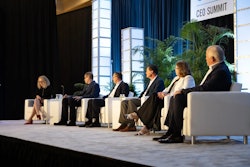
 Christine KieslingPhoto: Courtesy of Encore
Christine KieslingPhoto: Courtesy of Encore
As we approach Global Meetings Industry Day, we’re going to hear a lot about the economic value of our industry. That’s an important message, but as event designers, we should also be talking about the intrinsic value of meetings and events and how they can be most impactful to our organizations.
In the absence of being together in the pandemic, companies around the world learned how difficult it can be to connect, inspire, motivate, and ultimately move people to deliver business results. The silver lining? Our stakeholders have aligned on The Great Lesson: When we’re together, anything is possible. When we’re apart, achieving business goals proves to be much more difficult.
As meeting professionals, you are in the power seat to deliver the very connection that drives the collaboration and community building that spurs innovation and change in organizations, ultimately creating better businesses, better communities, and a better world.
The trick here is that just meeting isn’t what delivers results. It’s how we meet that can change the world.
At Encore, we’ve developed a strategy practice to assist our customers with delivering impactful events over a length of time to increase event ROI and stakeholder appreciation. Designing events with purpose that deliver measurable results is the way to ensure your leaders continue to value the power of meeting in person. It’s also a way to ensure the events team has a seat at the C-suite table to design for impact and change.
Here are a few ideas to consider to elevate your event strategy...
1. Align to the organization’s greater goals.
Understanding the focus and priorities of the organization for the year and what’s most salient to leadership will enable you to design events that support that effort. Think about how your event experiences can deliver on the greater purpose of the organization and align with its commercial objectives.
2. Design for sentiment with stakeholder input.
At Encore, we say we have to “earn their attendance, and then earn their attention.” A roadmap that outlines of all of your stakeholder groups’ interests, pain points, and desires can illuminate a clear path forward to impacting desired emotional outcomes from the event among each group. Don’t know everyone’s general sentiments? Conduct a pre-event behavioral study or survey. In essence, knowing how various stakeholders feel upfront and then designing to impact those feelings will deliver a greater perceived value of the event.
3. Make in-person engagement worth it.
Great events don’t have to be about world-class venues and celebrity sightings. Encore’s decades of research on in-person event engagement shows the single most important factor for event success is purpose. Whatever your in-person event budget, spend it on programming that invests your teams in a shared mission. They will leave the event motivated and empowered to achieve ambitious goals.
4. Measure human impact.
After clearly identifying the organization’s goals and road mapping the interests of the various stakeholder groups, measure the change in attitudes, beliefs, or perceptions of your organization across your entire event calendar, not just after a singular event.
5. Keep the good will flowing.
A long-term, multi-event strategy with pre- and post-event communication strengthens the bonds built in person, nurtures the change afoot, and optimizes the opportunities for organic personal connections and community building.
We know that events are essential to business because they facilitate the human-powered collaboration and innovation that’s fundamental to growth. Let’s align with our stakeholders by speaking the language of strategy, finding win-win opportunities, and delivering irrefutable measurements of change for our organizations.
Together, we can keep the momentum of The Great Lesson going. Together, we can design to change the world.



















